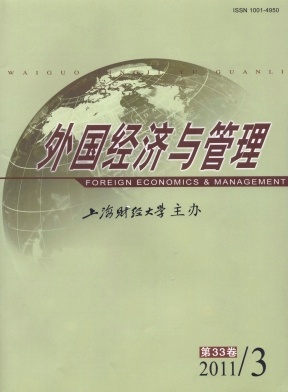克里斯滕森的管理理论建构方法评介
外国经济与管理 2011 年 第 33 卷第 03 期, 页码:9 - 18
摘要
参考文献
摘要
本文首先介绍了克里斯滕森的研究方法——管理理论建构的三个主要方面(即管理理论建构的两个程序和三个步骤、反常现象在管理理论建构中的价值和研究方法、以需求为导向的情境分类法),然后分别评价了它们的理论和实践意义,最后展望了克里斯滕森的管理理论建构方法在管理学研究中的应用前景。
[1]Bower,J L,and Christensen,C M.Disruptive technologies:Catching the wave[J].Harvard Business Review,1995,73(1/2):43-53.
[2]Hart,S L,and Christensen,C M.The great leap:Driving innovation from the base of the global pyramid[J].MIT Sloan Man-agement Review,2002,44(1):51-56.
[3]Christensen,C M,Anthony,S D,and Roth,E A.Seeing what’s next:Using the theories of innovation to predict industrychange[M].Boston:Harvard Business Press,2004.
[4]Christensen,C M.The ongoing process of building a theory of disruption[J].Journal of Product Innovation Management,2006,23(1):39-55.
[5]Carlile,P R,and Christensen,C M.Practice and malpractice in management research[R].Working Paper,Harvard BusinessSchool,2005.
[6]Gilbert,C G,and Christensen,C M.Anomaly seeking research:Thirty years of development in resource allocation theory[A].in Bower,J L,and Gilbert,C G(Eds.).From resource allocation to strategy[C].Oxford:Oxford University Press,2005:71-90.
[7]Christensen,C M,and Raynor,M.The innovator’s solution[M].Boston:Harvard Business Press,2003.
[8]Wallace,D.The logic of science in sociology[M].Chicago:Aldine,1971.
[9]Kuhn,T.The structure of scientific revolutions[M].Chicago:University of Chicago Press,1962.
[10]Porter,M E.The competitive advantage of nations[M].New York:Free Press,1990.
[11]Popper,K.The logic of scientific discovery[M].New York:Basic Books,1959.
[12]Christensen,C M.The innovator’s dilemma:When new technologies cause great firms to fail[M].Boston:Harvard BusinessPress,1997.
[13]Yin,R K.Case study research-Design and methods[M].Thousand Oaks:Sage Inc.,1994.
[14]Johnson,H T,and Kaplan,R S.Relevance lost:The rise and fall of management accounting[M].Boston:Harvard BusinessPress,1987.
[15]Chesbrough,H W.The differing organizational i mpact of technological change:Acomparative theory of institutional factors[J].Industrial and Corporate Change,1999,8(3):447-485.
[16]Evert,G.Qualitative methods in management research[M].Thousand Oaks:Sage Inc.,1994.
[17]Levit,T.Marketing myopia[J].Harvard Business Review,1960,38(7/8):45-56.
[18]Fremont,E K,and Rosenzweig,J E.Organization and management:A systems and contingency approach[M].(3rdEd.).New York:McGraw-hill Book Company,1974.
[2]Hart,S L,and Christensen,C M.The great leap:Driving innovation from the base of the global pyramid[J].MIT Sloan Man-agement Review,2002,44(1):51-56.
[3]Christensen,C M,Anthony,S D,and Roth,E A.Seeing what’s next:Using the theories of innovation to predict industrychange[M].Boston:Harvard Business Press,2004.
[4]Christensen,C M.The ongoing process of building a theory of disruption[J].Journal of Product Innovation Management,2006,23(1):39-55.
[5]Carlile,P R,and Christensen,C M.Practice and malpractice in management research[R].Working Paper,Harvard BusinessSchool,2005.
[6]Gilbert,C G,and Christensen,C M.Anomaly seeking research:Thirty years of development in resource allocation theory[A].in Bower,J L,and Gilbert,C G(Eds.).From resource allocation to strategy[C].Oxford:Oxford University Press,2005:71-90.
[7]Christensen,C M,and Raynor,M.The innovator’s solution[M].Boston:Harvard Business Press,2003.
[8]Wallace,D.The logic of science in sociology[M].Chicago:Aldine,1971.
[9]Kuhn,T.The structure of scientific revolutions[M].Chicago:University of Chicago Press,1962.
[10]Porter,M E.The competitive advantage of nations[M].New York:Free Press,1990.
[11]Popper,K.The logic of scientific discovery[M].New York:Basic Books,1959.
[12]Christensen,C M.The innovator’s dilemma:When new technologies cause great firms to fail[M].Boston:Harvard BusinessPress,1997.
[13]Yin,R K.Case study research-Design and methods[M].Thousand Oaks:Sage Inc.,1994.
[14]Johnson,H T,and Kaplan,R S.Relevance lost:The rise and fall of management accounting[M].Boston:Harvard BusinessPress,1987.
[15]Chesbrough,H W.The differing organizational i mpact of technological change:Acomparative theory of institutional factors[J].Industrial and Corporate Change,1999,8(3):447-485.
[16]Evert,G.Qualitative methods in management research[M].Thousand Oaks:Sage Inc.,1994.
[17]Levit,T.Marketing myopia[J].Harvard Business Review,1960,38(7/8):45-56.
[18]Fremont,E K,and Rosenzweig,J E.Organization and management:A systems and contingency approach[M].(3rdEd.).New York:McGraw-hill Book Company,1974.
引用本文
白胜. 克里斯滕森的管理理论建构方法评介[J]. 外国经济与管理, 2011, 33(3): 9–18.
导出参考文献,格式为:
下一篇:创业政策与创业活动关系研究述评





 5163
5163  439
439

